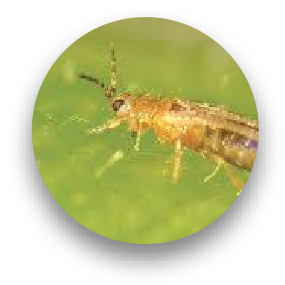How do you recognise thrips?
Thrips cause sucking damage to leaves, flowers and fruits. In particular, this can lead to significant damage to the plant’s ovary.
Thrips leave silver-brown marks after feeding on leaf cells. These insects are characterised by their adaptability. There are various species, but the Californian thrips (Frankliniella occidentalis) and the tobacco thrips (Thrips tabaci) are especially well-known.
Life cycle
There are six stages in the life cycle of thrips. The female thrips lays eggs, up to 75-125 of them at an optimal temperature. There are two larval stages, a pre-pupal and a pupal stage, and the adult stage. The larvae are very active and mobile. Pupation takes place on the ground (especially in outdoor crops such as Chrysanthemum and organic greenhouse vegetables) or on the underside of leaves.
Type of damage
- Thrips readily transmit bacteria and viruses. The California thrips can transmit the tomato spotted wilt virus.
- In ornamentals, leaf and flower damage can result in discoloration.
- In fruit crops, the damage can lead to deformed fruit.


